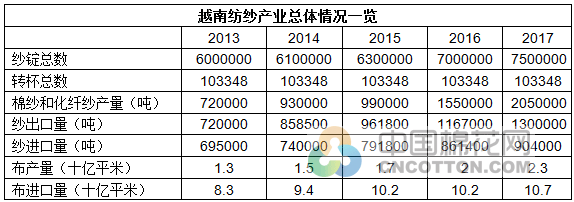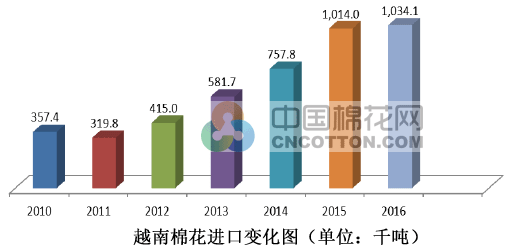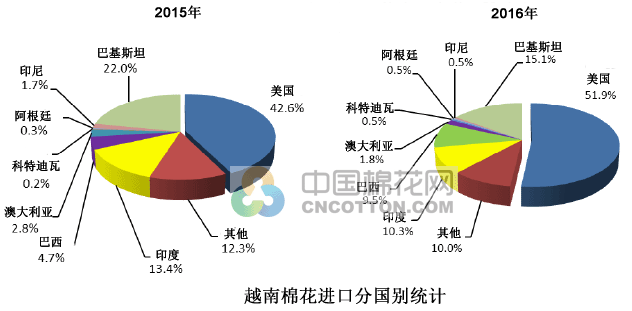Overview of Vietnam cotton textile market
In 2016, Vietnam’s textile and apparel exports amounted to US$28.5 billion, a year-on-year increase of 5%, accounting for 16% of Vietnam’s total foreign trade exports. From 2014 to 2016, Vietnam’s textile and apparel export growth rate declined year by year, 20.9%, 10.9%, and 5% respectively. The main reason was that export demand was stagnant and competition from China, India, Pakistan, and Bangladesh was very fierce. Vietnam’s textile and apparel exports are expected to grow by 6-8% in 2017.
Currently, the United States is Vietnam’s largest market for textile and apparel exports. In 2016, Vietnam’s textile and apparel exports to the United States increased by 5%, reaching US$11.4 billion, accounting for 40.3%. It is expected to reach US$11.7 billion in 2017, a year-on-year increase of 7%.
In addition to the United States, the main markets for Vietnam’s textile and clothing exports include the European Union (12%), Japan (10.2%), and South Korea (8%). The Vietnam-EU free trade agreement will come into effect in 2018. In recent years, Vietnam’s textile and garment industry has continued to absorb a large amount of investment from domestic and foreign countries, covering the entire industrial chain, and welcomes new opportunities brought by free trade agreements.
65% of Vietnamese yarn is exported, mainly to China, South Korea, and Türkiye. The total export volume in 2015 was 1.17 million tons, a year-on-year increase of 21.4%, of which 65% (743,000 tons) was cotton yarn, a year-on-year increase of 26%. China is the largest importer of Vietnamese cotton yarn, importing a total of 625,000 tons in 2016, accounting for 84% of Vietnam’s total cotton yarn exports. Therefore, changes in the Chinese market are of great importance to Vietnam.
Recently, the Chinese government has vigorously developed the textile industry in the western region and actively digested cotton reserves. Domestic cotton prices have gradually aligned with international cotton prices, which has sounded the alarm for Vietnamese spinning mills. Fortunately, Vietnam’s cotton yarn exports have not declined at this stage. In 2016, Vietnam’s cotton yarn exports to China increased by 24% year-on-year, while India and Pakistan’s cotton yarn exports to China dropped by 41% and 28% respectively. The Vietnamese industry hopes that Vietnam’s geographical advantages, cost advantages and the free trade agreement between China and ASEAN can continue to promote Vietnamese cotton yarn exports to China. The free trade agreement between China and ASEAN allows Vietnamese cotton yarn to enter the Chinese market duty-free, while China’s quota-free imports of cotton need to pay 40% import tariffs, and the Vietnamese spinning industry has benefited greatly from this.
The other two main export regions of Vietnamese cotton yarn are South Korea and Turkey. In 2016, exports to these two countries were 41,000 tons and 27,000 tons respectively, a year-on-year increase of 52% and 80%. It is expected that Vietnam’s cotton yarn exports to South Korea will increase in the future, while exports to Turkey will decrease due to the recovery of Turkish cotton production.

Almost 100% of Vietnam’s textile cotton is imported. The main sources include the United States, India, Brazil, Australia, and Cote d’Ivoire. The above-mentioned regions account for 70-80% of Vietnam’s total cotton supply. Recently, Vietnam has also begun to try to import Argentine cotton and African cotton, but the quantity is very small.
In the future, Vietnam’s cotton consumption growth rate will still be the fastest, and cotton imports will continue to increase. China, Turkey, and South Korea have very strong demand for Vietnamese yarn, which has strongly stimulated Vietnam’s cotton imports. In 2016, Vietnam imported 1.03 million tons of cotton, a year-on-year increase of 2%. Imports are expected to increase by 10% in 2017.
U.S. cotton has been Vietnam’s largest source of cotton imports for the past ten years. In 2016, the United States exported 537,000 tons of cotton to Vietnam, with a value of US$786.3 million, a year-on-year increase of 24.3% and 26.3% respectively. The proportion of US cotton in Vietnam’s cotton imports increased from 42.6% in 2015 to 52%. In 2016, only the United States and Australia saw positive growth in cotton exports to Vietnam, while other varieties experienced overall decreases.
Vietnam’s cotton imports are expected to increase to 1.15 million tons in 2016/17, a year-on-year increase of 15%. Based on the current expansion rate of Vietnam’s textile industry and the international market’s demand for Vietnamese yarn imports, Vietnam’s cotton imports in 2017/18 are expected to reach 1.26 million tons, a year-on-year increase of 10%.
In 2016, Vietnam’s demand for U.S. cotton imports increased significantly due to the following factors: First, the demand for Vietnamese yarn in domestic and foreign markets continued to increase, especially from China, Turkey, and South Korea; second, investors in large-scale textile mills in Vietnam were China, Taiwan, and South Korea, these countries and regions have special preferences for U.S. cotton; third, India’s cotton exports have decreased; fourth, Pakistan’s cotton supply has dropped significantly.
In 2015/16, the United States exported 421,000 tons of cotton to Vietnam, with a value of US$598 million, a year-on-year increase of 4% and 1% respectively. In 2016/17, the situation of U.S. cotton exports to Vietnam is even more promising. In the first seven months, exports have reached 302,000 tons, a year-on-year increase of 64%. If this trend continues, U.S. exports to Vietnam are expected to reach a new high of 500,000 tons this year, a year-on-year increase of at least 20%.
Driven by foreign demand for cotton yarn, Vietnam’s cotton consumption continues to increase. Vietnam’s cotton imports in 2016/17 are expected to reach 1.15 million tons, a year-on-year increase of 15%, of which about 80% is produced in cotton yarn, which is mainly exported to China (accounting for more than 80% of output). If China continues to import Vietnamese yarn and reduces its imports of Indian yarn and Pakistani yarn, Vietnam’s cotton consumption will expand to 1.26 million tons in 2017/18, a year-on-year increase of 10%.
From April to May 2016, the average cotton import price in Vietnam fell to US$1.5/kg, the lowest in the past five years. The average import price began to rebound and gradually increased in June 2016, reaching US$1.79/kg in March 2017.
���

AAA
Disclaimer:
Disclaimer: Some of the texts, pictures, audios, and videos of some articles published on this site are from the Internet and do not represent the views of this site. The copyrights belong to the original authors. If you find that the information reproduced on this website infringes upon your rights and interests, please contact us and we will change or delete it as soon as possible.
AA





